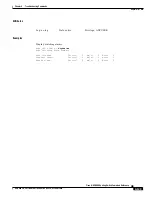
9-136
Cisco MGX 8850 Routing Switch Command Reference
Release 2.0, Part Number 78-10467-04 Rev C0, October 2001
Chapter 9
Troubleshooting Commands
dspxbarerrcnt
dspxbarerrcnt
Display Crossbar Error Counters—display the count of various types of errors.
The dspxbarerrcnt command shows numbers of various types of errors on each slot-link. Note that the
error can occur anywhere along the path of the ASIC and the hardware on the service module. The types
of errors apply to the 60-byte switch frames.
Note
This low-level command applies to software or hardware development and is not useful for
troubleshooting the network or node. For troubleshooting the node, use dspndalms and dspswalms.
You can see the thresholds of the alarms that the errors trigger by using dspxbarerrthresh.
The following types and instances of errors appear by slot number (see example screen):
•
Loss of synchronization between the ASIC and the queuing circuitry on the service module. The
synchronization in this case applies to the timing of the internal switching frames (Sframes). Loss
of synchronization is a very serious error.
•
Receiver code violations (Rx Cv column in the display).
•
Receiver disparity errors (Rx Disp column in the display). A disparity error is a summary of five
ASIC-specific alarms.
•
Transmitter parity errors.
•
CRC failures for the header or the payload of the 60-byte Sframe.
•
Failures to remap between slots as needed or excessive remapping between slots (Slot Remap and
Slot Recur columns in the display).
•
Parity errors in back-pressure messages.
A top-down sequence of troubleshooting commands for isolating faults in the switching fabric are:
1.
dspndalms
2.
dspswalms
3.
dspxbaralm
4.
dspxbarerrcnt
Cards on Which This Command Runs
PXM45
Syntax
dspxbarerrcnt <slot> <plane>
Syntax Description
slot
The slot of the switching fabric. On the MGX 8850 node, the slot is 7 or 8.
plane
The plane is the number of the switch ASIC. On the MGX 8850 node, the range for
either slot is 0–2.
















































